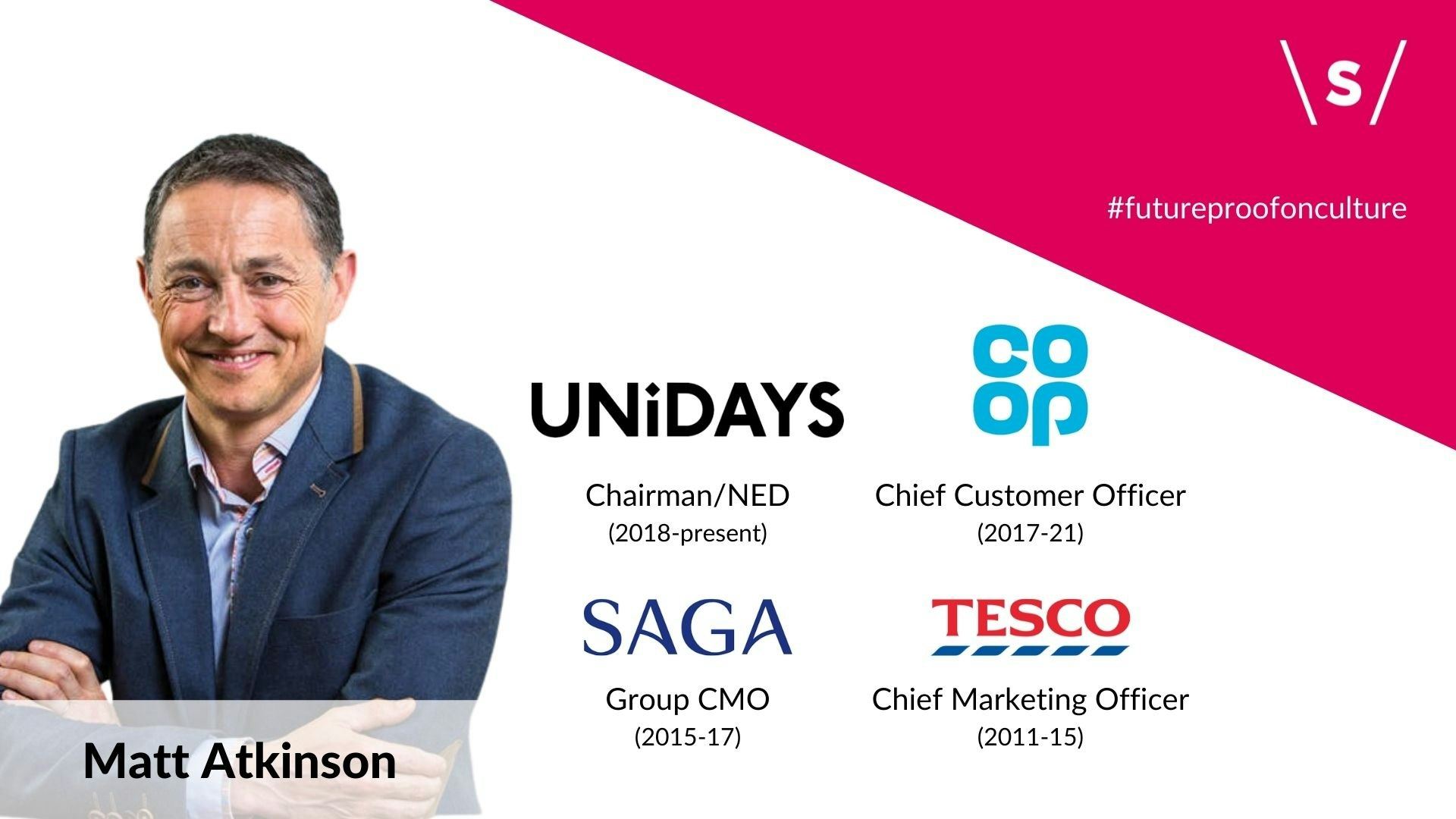It’s easy to forget that what seems blindingly obvious to some, isn’t to all.
Innovation evangelists see a world in flux, with transformative change happening in most categories and most geographies.
But not everyone is a convert. Some people out there simply don’t recognise the change though it’s present in their own lives as consumers — "I don’t see the evidence". Some see disruption, but just can’t equate it to their own context — "Yes it’s happening, but not to us". And others see it as a problem for a future generation of leaders — "Disruption is on the horizon, but no time soon".
Innovation leaders need to get organisations, starting with the executive committee, on the same page — and they can’t assume that plain old common sense will do the job for them.
As part of our #FutureProofonCulture series, Sifted sat down [virtually] with Matt Atkinson, a seasoned commercial and innovation leader, to reflect on his experience at Tesco, Saga and the Co-op Group — and what to do when common sense isn’t that common.
Taking innovation seriously
The first job is to make sure that the executive committee is really committed to innovation, that they understand what it does (and doesn’t) mean for their context, that it’s seen as a legitimate investment, that it is adequately resourced. And that they agree on where and why it will focus.
According to Atkinson, nothing meaningful can really happen with an innovation agenda without two key foundations — a "burning platform", and a pot of at-risk capital.
“Whether you use the term or not, a burning platform is critical,” he says. “You don’t get movement unless there’s a threat to life, and then you need to direct that movement towards a destination that people can understand. And you need both of these things to get an innovation agenda that the executive committee is truly behind.”
Every innovation leader needs an arsenal of “decent insight” — short, medium and long-range signals that can be drawn on to stimulate debate about the future. Tesco, for example, had its "Custom Forecast", the first of which was created in 1995 by Tim Mason, then UK marketing director, and continued into this decade.
Sometimes you’ve got to rattle people’s cages, just enough that they say 'I get it, we need to address this, and we need to dedicate some resource to exploring it'
“The forecast was a set of strategic excursions into the things that could affect the marketplaces in which Tesco operated,” Atkinson explains. “Basically, a set of provocations about things that could potentially happen in the future. Even if only 20% of these came true, they would significantly, or even drastically, impact the business we had today.
“These forecasts provoked critical debate over many years, but it wasn’t that they were right or wrong. It was that they forced the business to consider critical external forces, in some cases far ahead of their time, such as migration to the cloud and AI.”
Atkinson cautions that such forecasts or scenario exercises have to be grounded in an at least tangential connection to the markets in which the core business operates, to avoid them losing credibility or any accusations of fad-following. But it's a good way of putting risk on the board’s agenda.
“Sometimes you’ve got to rattle people’s cages, just enough that they say ‘I get it, we need to address this, and we need to dedicate some resource to exploring it’. That gives you the opportunity to secure the second foundation — a pot of at-risk capital.”
Securing the money
Once investment is allocated to an innovation agenda, transparency and rigour are critical for sustaining C-suite commitment and confidence.
“First, you’ve got to be mindful of what it will really take to invest and experiment,” he says. Being too conservative at this stage can come back to bite you further on — it’s better to ask the chief financial officer to swallow a bigger pill up front, than to come back and have to make the case for additional funds at a later stage, or to admit the investment planned wasn’t enough.
“Alongside that, you’ve got to establish clear success criteria against which you’ll deploy that capital, so that the people trusting you to invest the organisation’s hard-won capital know that you’ll be respectful and disciplined.”
Innovation still needs to have discipline, to have reporting, to have things documented
Atkinson likes breaking innovation investments into a number of stages, with clear success criteria for each and estimates of the proportion of investment that will be required at each stage.
“If we set aside a few million quid for an innovation programme, I might say that phase one is investigative, and will only take us 25-30 percent into that budget. We’ll then review progress against our success criteria, and decide to move onto the next stage — prototyping or testing, for instance — with the next proportion of the budget.”
Ultimately, Atkinson argues that innovation requires discipline, and that doesn’t have to compromise its inherent creative or exploratory nature, or the potential for failure.
“Innovation is still a business activity,” he says. “It still needs to have discipline, to have reporting, to have things documented. If 50% of innovation is fast-failure — and failure is a legitimate innovation outcome — you’ve got to capture those lessons and what you learn, otherwise you’re unlikely to secure that investment again.”

Making the culture connection
There are three different types of innovation that organisations can undertake — incremental, discontinuous and transformative. And it’s in the latter two, Atkinson argues, that culture can be a significant limiting factor.
But how do you make the culture connection with a leadership team that may not be connecting the same dots, or giving it the same level of importance?
“I like to start with a quote,” he says. “What got you here won’t get you there.
“I ask executives, if you look up out of the cockpit, do you see signals around you of disruption, velocity of change, discontinuity, uncertainty, challenges emerging in different segments of your value chain? Do you see a stable landscape or an unstable one? I think the answer, unless you’re truly ignorant or incompetent, is ‘yes, we see a lot of that happening’.”
If executives acknowledge change, then the conversation, Atkinson says, has to turn to the operating model.
I ask executives, if you look out of the cockpit, do you see uncertainty? The answer, unless you're truly ignorant or incompetent, is 'yes'
“Today’s operating model is designed to support a specific way of growing. And underpinning it are a host of metrics, KPIs, systems, processes, methodologies — all enshrined in organisation to take existing product A or division B to its next agreed phase of performance.
“You then have to ask, is all of that really going to find you the next ‘new thing’, one which at its heart might fundamentally challenge the status quo, your business model or your role in the value chain?”
He advises asking an executive committee what they believe it is that enables organisations to prosper, out-compete and grow sustainably over a long period of time. To think of those they admire, respect or wish to emulate, in or out of category. And he contends that at least one of the factors that the executives would list, or could at least be shepherded towards, would be culture, capability and mindset.
“As you take people through this thought process, it’s about connecting the dots. Building the realisation that the culture, capability and mindset of today are all geared to the existing operating model and the business ‘as is’ today. That all of those metrics, KPIs, systems, processes and methodologies are supporting the existing. And that combined, they’re basically wired to create a faster horse.”
No innovation is an island
Some might argue that innovation can still succeed in spite of an organisation, not because of it. With enough resource, leadership support and brute force, you can bulldoze or find ways to work around the limitations of an organisation and land innovations in-market without investing in evolving the culture, or taking the organisation of today with them.
But you have to ask yourself: "Is your outcome to ‘just create some innovation’, or is your outcome to help the organisation create some innovation that reinvents it at scale?”
If it’s the former, the bulldozer strategy may work — if one or more of three conditions are met. First, that you’ve got all of the money and resource you need, including talent. Second, that you don’t need the core organisation to be successful (such as its channels to market or existing infrastructure). And third, that you’re so confident that what you’re investing in building will be so transformative and so appealing, that the core organisation would beat a path to your door irrespective
If you’ve been isolated and done nothing to bring the organisation with you, you’ve got a problem. The old world will kill the new world
“It’s probably not a particularly pervasive strategy, or one likely to work in most organisations,” Atkinson says. “And in most cases I’ve seen, it’s not led to long-term success.”
The definition of successful innovation, he says, is something that can go to scale. And to do that, he cautions, at some point you’re likely to need the core organisation.
“If you’ve got innovation in your job title, you’re trying to create startups or new ways of doing things such that they can get scaled. Ultimately, at some point in time, that will require the organisation to embrace the acorn. If you’ve been so isolated, and done nothing to bring the organisation with you, you’ve got a problem.”
“The old world,” he adds, “will kill the new world.”
Innovation creations, he says, will at some point meet the incumbent mindset of the organisation. How that meeting goes depends entirely on culture.
“If the incumbent mindset is one of ‘I don’t like you lot over there, I don’t know what you’re doing, I don’t understand why you’re spending the money we’ve earned on something which is never going to work anyway’… then you’re going to spend your time in seven different meetings with nine different people, trying to explain what you’re doing — and that’s culture.”
Getting over the idea of ‘just good enough’
A final familiar encounter of the innovation leader is inertia. The belief, often fairly founded, that the business is doing just fine, it’s making money, it’s healthy — so why change? Why divert capital, resource or attention away from a perfectly successful enterprise today, in pursuit of an uncertain tomorrow?
Changing that mindset, says Atkinson, has to start with the CEO.
“If you’re on an eight-strong executive committee and seven of them don’t want what you’re selling, you’re never going to convince them on your own — you need some external leverage to make it happen.
“If you’re in that position you need to convince the CEO and the non-execs to provoke the organisation to ask the questions it should be asking. Otherwise you’re going to be on a long journey of singing for your supper.”
Have a chat with the chair and plant a few seeds in his or her back garden. You’ll soon find their questions on the CEO's agenda
Atkinson advises that the board and shareholders are a fruitful place to start. Non-execs, he suggests, ultimately sign off strategy and budgets, so getting in front of them to “roll in a few grenades” can prompt them to start asking whether investment in innovation and risk is appropriate given our changing landscape.
“Have a chat with the chairman and plant a few seeds in his or her back garden. You’ll soon find their questions on the CEO's agenda for the rest of the executive committee”
Timing is crucial. “As the innovation leader, you’re unlikely to be able to show up mid-cycle and fight the incumbent force with a new agenda. Strategic or annual planning cycles, however, are a key lever. People are thinking anew about priorities, budgets, allocation of capital and resources — this is the optimal time to bring fresh questions to the table, and begin that process of building towards a shared innovation agenda.”
Share your perspective
We hope Matt’s reflections provide some food for thought — but this isn’t intended to be a one-way conversation. We’d love to hear from you…
⛔️ How you’ve overcome barriers to building a shared innovation agenda
🧬 Steps you’ve taken to put culture on the executive committee agenda
Share your examples and ideas in the comments below, or on LinkedIn or Twitter using the hashtag #FutureProofonCulture.
Thomas Brown is Sifted’s corporate innovation reporter and a freelance journalist, author and consultant.You’ll find him tweeting from @ThinkStuff.
Matt Atkinson is an experienced CEO, chief customer officer and NED. He was chief marketing officer at Tesco plc (2011-15), group CMO at Saga plc (2015-17) and chief customer officer at The Co-op Group (2017-2021). He is currently non-executive chairman of UNiDAYS.



